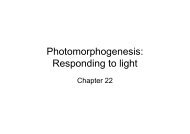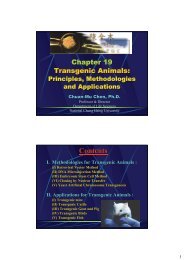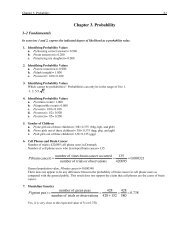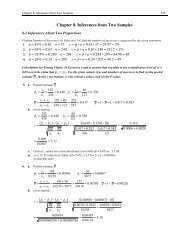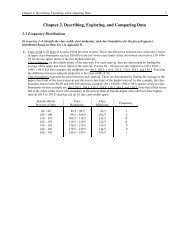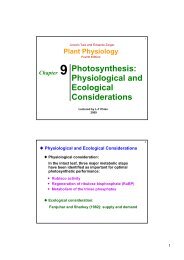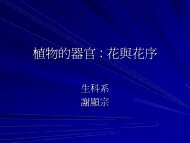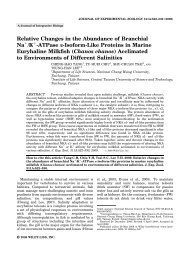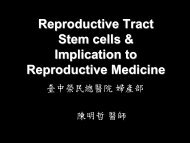218 <strong>Chapter</strong> 7: <strong>Hypothesis</strong> <strong>Testing</strong> <strong>with</strong> <strong>One</strong> <strong>Sample</strong>12. The claim is that the mean starting salary for college graduates who have taken a statistics course is equal to$46,000, so this is a two-tailed test. The sample size is n = 27, the sample mean is x = 45,678, and the samplestandard deviation is s = 9,900. The significance level is 0.05.The test statistic is t = x − µ 45,678 − 46,000= =−0.169s / n 9,900 / 27In a two-tailed test at the 0.05 significance level <strong>with</strong> 26 degrees of freedom, the critical values are±t α /2=±t .025=±2.056.Since the absolute value of the test statistic is smaller than 1.315, the P-value is greater than 0.20.We fail to reject the null hypothesis.There is not sufficient evidence to warrant the rejection of the claim that the mean salary for college graduateswho have taken a statistics course is equal to $46,000.In Exercises 13-24, assume that a simple random sample has been selected from a normally distributedpopulation and test the given claim. Unless specified by your instructor, use either the traditional method orthe P-value method for testing hypotheses.13. Effect of Vitamin Supplement on Birth WeightThe claim is that the mean birth weight for all male babies of mothers given vitamins is 3.39 kg, so this is atwo-tailed test. The P-value is provided by the output, and is 0.103, and we would fail to reject the nullhypothesis. There is not sufficient evidence to warrant the rejection of the claim that the mean birth weight forall male babies of mothers given vitamins is 3.39 kg. In other words, there isn’t enough evidence to say thatthe vitamin supplements have an effect on birth weight.14. Pulse RatesThe claim is that the mean pulse rate for statistics students is greater than 60 beats per minute. The P-value forthe claim is displayed <strong>with</strong> the calculator output, and is 0.0000019<strong>7.</strong> We would reject the null hypothesis. Thesample data support the claim that the mean pulse rate for statistics students is greater than 60 beats perminute.15. Heights of ParentsThe claim is that women tend to marry men who are taller than themselves, or that the mean differencebetween husbands and wives is greater than zero, so this is a right-tailed test. The sample size is n = 20 makingthe degrees of freedom df = 19, the sample mean is x = 4.4 , and the sample standard deviation is s = 4.2. Thesignificance level is 0.01.H 0 : µ = 0H 1 : µ > 0The test statistic is t = x − µs / n = 4.4 − 04.2 / 20 = 4.685In a right-tailed test at the 0.01 significance level <strong>with</strong> df = 19, the critical value is t α= t .01= 2.539.In the row for 19 degrees of freedom, the test statistic falls to the left of 2.861 so the P-value is less than 0.005.We reject the null hypothesis.The sample data support the claim that women tend to marry men who are taller than themselves.16. Monitoring Lead in AirThe claim is that the amount of lead in the air in Building 5 of the World Trade Center following the collapseof the two building is greater than 1.5 µg/m 3 , so this is a right-tailed test. The sample size is n = 6 making thedegrees of freedom df = 5. The significance level is 0.01. Calculating x from the sample data givesx = Σx /n = 9.23/6 = 1.538Calculating the sample standard deviation from the data givess = nΣ(x 2 ) − (Σx) 226 ⋅ 32.520 − (9.23)= = 1.914n(n −1)6 ⋅ 5We move on to the test.H 0 : µ = 1.5H 1 : µ > 1.5
<strong>Chapter</strong> 7: <strong>Hypothesis</strong> <strong>Testing</strong> <strong>with</strong> <strong>One</strong> <strong>Sample</strong> 219The test statistic is t = x − µ 1.538 −1.5=s / n 1.914 / 5 = 0.044In a right-tailed test at the 0.01 significance level <strong>with</strong> df = 5, the critical value is t α= t .01= 3.365.In the row for 5 degrees of freedom, the test statistic lies above 1.476, so the P-value is greater than 0.10.We fail to reject the null hypothesis.There is not sufficient sample evidence to support the claim that the amount of lead in the air in Building 5 ofthe World Trade Center following the collapse of the two building is greater than 1.5 µg/m 3 .The assumption that the data came from a normally distributed population seems unrealistic, as there is anextreme outlier in the data set.1<strong>7.</strong> Sugar in CerealThe claim is that the mean sugar content for all cereals is les than 0.3g, so this is a left-tailed test. The samplesize is n = 16 making the degrees of freedom df = 15, the sample mean is x = 0.295, and the sample standarddeviation is s = 0.168. The significance level is 0.05.H 0 : µ = 0.3H 1 : µ < 0.3The test statistic is t = x − µ 0.295− 0.3=s / n 0.168 / 16 =−0.119In a left-tailed test at the 0.05 significance level <strong>with</strong> df = 15, the critical value is −t α=−t .05=−1.753.In the row for 15 degrees of freedom, the absolute value for the test statistic falls to the right of 1.341 so the P-value is greater than 0.10.We fail to reject the null hypothesis.There is not sufficient sample evidence to support the claim that the mean sugar content for all cereals is lessthan 0.3g.18. Treating Chronic Fatigue SyndromeThe claim is that the mean score on the fatigue scale is positive, or greater than zero, so this is a right-tailedtest. The sample size is n = 21 making the degrees of freedom df = 20. The significance level is 0.01.Calculating x from the sample data givesx = Σx /n = 84 /21 = 4.0Calculating the sample standard deviation from the data givess = nΣ(x 2 ) − (Σx) 2221⋅ 430 − (84)= = 2.168n(n −1)21⋅ 20We move on to the test.H 0 : µ = 0H 1 : µ > 0The test statistic is t = x − µs / n = 4 − 02.168 / 21 = 8.455In a right-tailed test at the 0.01 significance level <strong>with</strong> df = 20, the critical value is t α= t .01= 2.528.In the row for 20 degrees of freedom, the test statistic lies to the left of 2.845, so the P-value is less than 0.005.We reject the null hypothesis.The sample data support the claim that the mean score on the fatigue scale is positive. The treatments appear tobe effective.




